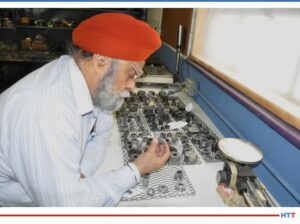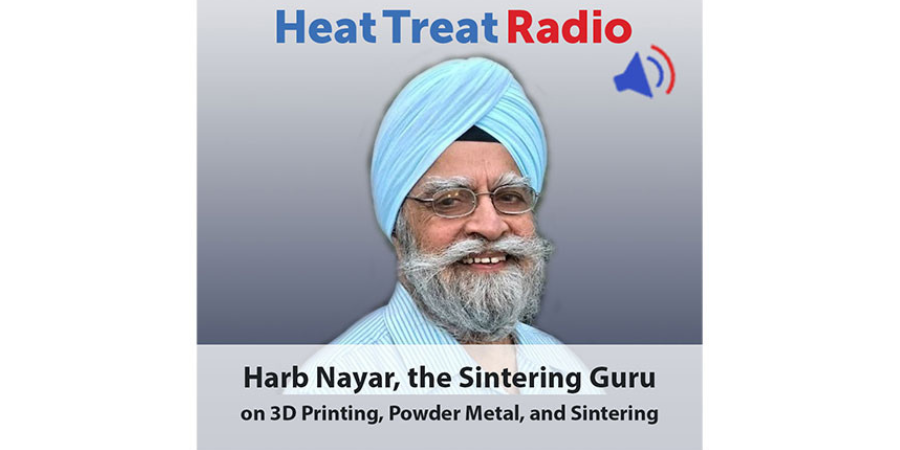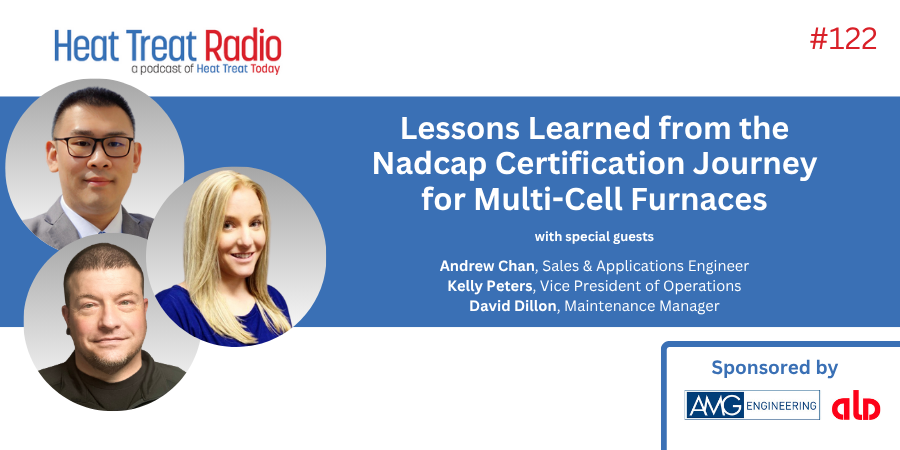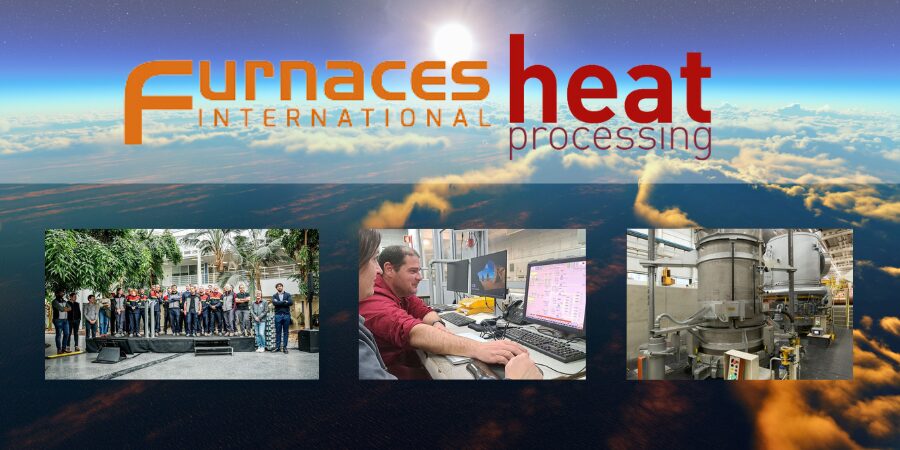 Welcome to another episode of Heat Treat Radio, a periodic podcast where Heat Treat Radio host, Doug Glenn, discusses cutting-edge topics with industry-leading personalities. Below, you can either listen to the podcast by clicking on the audio play button, or you can read an edited version of the transcript. To see a complete list of other Heat Treat Radio episodes, click here.
Welcome to another episode of Heat Treat Radio, a periodic podcast where Heat Treat Radio host, Doug Glenn, discusses cutting-edge topics with industry-leading personalities. Below, you can either listen to the podcast by clicking on the audio play button, or you can read an edited version of the transcript. To see a complete list of other Heat Treat Radio episodes, click here.
In this conversation, Heat Treat Radio host, Doug Glenn, interviews Mr. Harb Nayar, president and founder of TAT Technologies LLC. Harb is both an inquisitive learner and dynamic entrepreneur who will share his current interests in the powder metal industry, and what he anticipates for the future of the industry, especially where it bisects with heat treating.
Click the play button below to listen.
The following transcript has been edited for your reading enjoyment.
Harb Nayar (HN): My name is Harb Nayar. I am the president of TAT Technologies, LLC. It is a very small 10 year old company that focuses on powdered materials and processes, especially sintering.
Doug Glenn (DG): This experience you've had with powder metals stretches over 50 years. I understand that people recognize you as “the sintering guru” for the value that you've brought to the industry. Can you share what intrigued you about the powder metal process and the powder metal industry that began your lifelong interest?

HN: There is no doubt that PM (powder metallurgy) is a very, very unique manufacturing process to make metallic products. If I have to pick one thing that I would say which is almost becoming a destructive technology in the manufacturing of complex shapes (metallic products), that would be additive manufacturing using metal powders to start with. And you may ask why it's destructive. The answer is relatively short and simple. That it takes a totally different way of manufacturing. You are adding layer by layer to build a 3-dimensional component and therefore you can make unusual designs and unusual complex shapes out of it. The PM is used to make 2-dimensional and 3-dimensional parts for a very long time, but this one can make 4 dimensions. Now you may say there are only 3 dimensions, where are you coming up with the fourth one? Well, in my opinion, the fourth one in this case is emptiness. In other words, it can create design. Within the solid, you have empty spaces, so to speak, and that is what I call the fourth dimension. This is where the major benefit will be to reduce weight.
Now, to really give you how much design flexibility there is, I'll give a very simple example. Suppose you are trying to make this one piece, or many pieces, of a globe of the whole world, but you want it to be stainless steel. And you want to make it in one piece with no welding, but you want to show the hills and the valleys and the ocean and everything else, and you want to keep the interior of this globe empty to keep the weight light. You can only do this by additive manufacturing and to the best of my knowledge, there is no other way to make it. That is where I'm emphasizing the fourth dimension – the emptiness.
DG: Yes. And now this would have a pretty significant influence on both the aerospace and the automotive industries where lightweighting plays a key role.
HN: I think lightness, just as in the cellphone business or the semiconductor business where things became smaller and smaller, in the product line it's going to be, can we make it lighter and lighter, if for no other reason than to use less material to begin with. The other one I think that's going to emerge is most probably making more and more parts by powder metallurgy from metal powder which are 100% free alloyed. In other words, all the elements are in each metal powdered particle. In other words, you're starting with a micro ingot as opposed to a big ingot that you normally use to make bars, and then from bars you cut pieces, and then from those pieces you do hard forging or machining. But here, you will be starting from the other end where each powdered particle now is a micro ingot and the challenge is how you take billions of these micro ingots and make a 20 lb. part out of it. That’s the other thing that most probably is going to start picking up.

Especially the low alloy steel parts. My personal feeling is that a lot of technology, although it has already been developing, but, it will develop much more rapidly in the next 10 years. That is where the role of the heat treat people will be actually much bigger, because by doing a heat treat, you can always make an alloy or a material more strong, so to speak, as that's the main function of heat treat. But in the low alloy steels, the reason you are adding alloy is so that it's more conducive to heat treatment. Certain alloying elements help you to strengthen the material more than certain other elements. I think the powder metallurgy technique, each micro ingot is uniformly alloy, where when you start with a big billet, it's not uniformly alloyed. I think that the role of the PM would be to reduce those dimensional, (like mechanical properties in 3 dimensions are different if you're making something that originally was cast as a billet), where in the metal powder particle, because the distance is so small in each particle, each element is much, much more uniformly dispersed. And also, there are no stringers that you normally get when you're casting, let’s say, a 7” diameter bar or a 15” square bar, out of which you then make other things. Not only will the alloys be more uniformly distributed in the micro ingot, but there will be no stringer type of impurities.
DG: So then, Harb, what is your prognosis for the future of the industry looking forward?
HN: That is an unusually good question, and also a very complicated question. But I can make three or four general statements. One is that powder metallurgy is going to continue to grow. A lot of people will take issue with me, but in my opinion, with additive manufacturing coming in and with these other developments that I mentioned, in the last 2 – 3 years it has been below 6% growth rate. It used to be 7 -8% and it began to flatten out a little bit. I think that AM and this other micro ingot approach, I think that it will swing back to 7, 8 or 9% growth by the middle or latter part of this decade. And all these changes that are coming will affect heat treat. The way I see it, in heat treat, the changes will be based on two things: what are they heat treating right now? For example, if they're heat treating almost exclusively from macro ingots and now they have to worry about the micro ingot type of products, obviously heat treat has to shift somehow. The second one: how is being heat treated right now? That's where I feel that oil will be going down and other quenching techniques most probably will be coming up. Part of that will be influenced by as the PM makes inroads into machine parts or hard forged parts using macro ingots. The micro ingot will somehow affect the heat treat.
DG: So those will be the main things: that PM will continue to grow and elimination of oil.
HN: Well, the PM will continue to grow, but that will then affect the heat treat industry, yes.
DG: Harb, could you tell us how you got interested in powder metallurgy, and also how you came to be known as the 'sintering guru' in the United States?

HN: Well, it all started when I watched an American movie at 17 years old, in India, in English of course. At the age of 18, I came to study at Rensselaer Polytechnic Institute in Troy, NY in mechanical engineering. When I went back to India, I happened to see a monument that's called Delhi Iron Pillar. I was born in Delhi, I had seen it, but it never impressed me that much. But when I read the story behind it, that it was made by starting with iron oxide powders, and that got converted into a sponge iron and then sponge iron was hot forged into this 14 ton structure. It is the largest part known to be made by powder metallurgy and was made around 14 centuries ago and it still has not rusted. So with all the story behind it, there are still some mysteries behind it, but the main thing is that powder metallurgy impressed me. It changed my course.
DG: In fact, seeing the Delhi iron pillar did change Harb's life course. He went back to school and studied sintering and earned a master's degree in metallurgy at Notre Dame University. Then he poured himself into the practical, returning to Rensselaer Polytechnic Institute, where he earned his PhD. Shortly thereafter, Harb worked in a research lab for Copper Range Company where he researched the possibility of making copper strip directly from powder, as opposed to casting it from molten copper. Unfortunately, that research project never grew legs. His next employment, however, did bear fruit. After Copper Range, Harb moved to New Jersey, and here's what happened.
HN: So after working for Copper Range, I went to New Jersey and worked for an industrial gas company. It was called Airco Industrial. It was well known for making nitrogen, oxygen, hydrogen and many, many other gases. When I was hired, they had no powder metallurgy activity of any kind. So my first assignment was, can the powder metallurgy be used to be make electrodes, welding rods, etc, because Airco also had a welding products division. I then did make hardfacing rods and welding rods by powders.
DG: Although the welding products division was sold, Harb found a new home at Airco researching and developing synthetic gases. Remember, in the early 70's, there was the energy crisis and a concern that there would be a shortage of industrial gases. During his time at Airco, Harb was one of the early developers of synthetic gases, or what might be more commonly known today as mixed gases. After Airco, Harb took some extended time off to raise his young daughters after the untimely passing of their mother. After the daughters were out of the house, Harb wondered what he should do with himself. TAT Technologies, the company he currently owns and operates, was just the answer.
Harb, tell us a little about what you're currently doing with TAT Technologies.
HN: TAT stands for Temperature Atmosphere Time Technology. Whatever my thermal processing background was, I decided to work on that, but focus only on powder metallurgy to start with, not all the other thermal processes. In other words, start with sintering to begin with.
I opened a school to teach sintering, just like I learned when I left and came from India. I started teaching sintering but did it hands-on; not just lectures, but hands-on. So, I bought a sintering furnace for testing equipment and opened my own lab in 2012. We started with education and training, then added some R&D to it, then developed equipment that can help to increase the production rate in sintering furnaces by as much as 30 – 40% in existing furnaces. Slowly, we would begin to work with a very small number of people and that's what we've been doing until 2019. Then, of course, in 2020, COVID-19 came along. Just like in the 70's, the bad time, at least it appeared to be a bad time anyway, that there was a natural gas shortage, that gave the birth to Synthetic Atmospheres. That was my silver lining then. My silver lining this time is that it forced me to look into other projects which may be even more interesting. And I decided to build by intellectual property. So since then, I've received one patent, two are already applied for, two are in the process, and another four or five are waiting in line.

My future now is in two directions: One is to continue with what we became very good at until 2019 and make it go further, and the other is to, hopefully, develop this new project and figure out a way of commercializing them. I believe in the old theory “that one in hand is better than two in the bush,” I change it to “keep the one you have in the hand the best you can, and still go after the two in the bush.” This is what has evolved because of COVID-19.
DG: Let's stick with TAT for just a moment. Where do you see it going in the future?
HN: There are three activities that we plan to pursue based on the patents that are issued or are being issued. One is a project which promotes production of low alloy steels by powder metallurgy. I believe there is a very big future in that. In other words, how to bring out the better properties of a micro ingot compared to a big ingot and how to translate that into better products which require less energy and will cost less to manufacture. Right now they are being manufactured in one way or another by either machining or by taking a billet, chopping it down to small pieces and then doing hard forging. I plan to make the starting material, from my hard forging using low alloy steel, would be powders as opposed to a preform that originally was cast somehow somewhere. That's my one project. And that will affect heat treat quite a bit. Presently, most of the heat treat is done on parts which are really made by the big casting approach, ingot casting; these bring all the imperfection from the casting into the final product which is then heat treated. My question is that if the product was much more uniform, then it may develop somewhat different heat treat approaches and it most probably will reduce, if not eliminate, oil quenching.
DG: So, why the elimination of oil quenching?
HN: There are two reasons. One obviously is just safety as oil tends to catch fire, but the main reason is that if you can distribute the alloys more evenly, there is a high probability you need less total amount of alloying element, which will give you a similar mechanical property because it doesn't have some of these irregularities. Now that “most probability low alloy steel” with even a lower amount of alloying is going to be more conducive to faster quenching. In powder metallurgy – gas quenching is already used after sintering – they call it sinter hardening. In my opinion, heat treat will have to somehow modify its practices to deal with if the same forged product is really made from micro ingots as opposed to a macro ingot.
DG: Very interesting. So that is one prospect of three. What is another one?

HN: In the additive manufacturing, there are two weak points there, that's why it's not taking up as quickly, commercially, I'm talking, R&D, the money, the research, is going at a very high rate, but the actual production where you can see a part going in the automotive is not there yet. The reason is the shaping process – layer by layer – is somewhat slower. They have to speed it up quite a bit in order to make it what I call mass production. That's one, at the moment, still a bottleneck.
The second one is a bottleneck that they are not addressing yet because they feel they have to take care of the other bottleneck first, and that is because wherever there will be high volume of additive manufacturing, there the green part will have some binder in it. That binder has to be removed prior to sintering. Therefore, I am going to be focusing on binder, and start getting ready within a couple of years, for mass debinding.
Right now, the debinding is done in small batches only. I'm going to be ready for production on a mass scale when the shaping people start making the green parts faster. And it's much more challenging than the debinding in the conventional powder metallurgy because there the amount of binder, or what they call lubricant, by volume is less than 10%, whereas in the additive manufacturing, wherever they use the binder, is always much more than 10%. That makes it a bigger challenge to get rid of it. I already have an expertise in how to get rid of the binder in the conventional part of metallurgy, so I will use my dad’s know-how as a stepping stone to develop, what I call mass production, debinding operation. That's my second project.
The third one came directly out of COVID-19. I cannot get into it because there are still some patent issues involved here, but I want to replace N95, which is made from what's called unwoven polymer, and I want the filtering portion to be metallic. That would be my dream project.
DG: Any last messages for our listeners?
HN: We are not doing it, but we are open to it, and that is because your main listeners are heat treaters, so I'm open to them – that my background is furnaces and atmospheres and temperature – to anyone if they have problems to reduce the atmosphere cost, let's say. Or they want to increase the productivity of their furnaces, they could reach me and once I understand their need, I will be willing to work with them on how to accomplish those two goals: cost reduction, atmosphere reduction and the third will be energy production. I have a pretty good background in all of those three areas when it comes to thermal processes in general. Even though my focus right now is on sintering, that does not mean I cannot get into annealing or brazing or heat treating or tempering, and so on.
DG: Thanks for taking the time to talk to us, Harb.
HN: Thanks Doug
You can reach out to Harb Nayar by email at harb.nayar@tat-tech.com or at www.tat-tech.com.

To find other Heat Treat Radio episodes, go to www.heattreattoday.com/radio and look in the list of Heat Treat Radio episodes listed.






